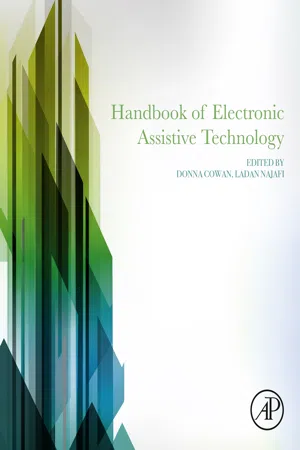
- 382 pages
- English
- ePUB (mobile friendly)
- Available on iOS & Android
Handbook of Electronic Assistive Technology
About This Book
Electronic Assistive Technology (EAT) is a subset of a wider range of products and services known as Assistive Technology (AT). AT is designed to support and enable people with disabilities, either acquired or congenital, to participate in activities with greater independence and safety. With a global aging population, it has an important role to play in enabling and supporting those with disability and their carers.
Handbook of Electronic Assistive Technology discusses a range of commonly available or emerging electronic assistive technologies. It provides historical background, advice when assessing for these devices and references different models of provision. It includes both medical and engineering aspects of provision. It is anticipated that the book will support students, trainees, and newly qualified Assistive Technology Practitioners to develop their understanding of the field, by considering the variables that could potentially influence the decision-making process when assessing for and providing this equipment. It also provides a reference point for those already practicing in this field and offers coverage of a broader range of technologies than clinicians may be exposed to, in their daily work
This is the first reference book to focus on a comprehensive set of electronic assistive technologies and discuss their clinical application.
- Provides comprehensive coverage of electronic assistive devices
- Gives an overview of physical and cognitive pathologies and approaches for utilizing electronic assistive devices for individuals affected by these pathologies
- Covers essentials for assistive technology practitioners, human factors and technologies
Frequently asked questions
Information
Basic Neurosciences With Relevance to Electronic Assistive Technology
Abstract
Keywords
Introduction
Concepts of Impairment Function and Participation
- 1. Health in terms of function, activity and participation; and
- 2. Disability in terms of impairment, limitation of activity and restriction in participation; from both an individual and societal perspective.

Basic Neurosciences
How the Central Nervous System Is Made – Neuroembryology
- • Endoderm (inner) develops into most of our internal organs.
- • Mesoderm (middle) develops into muscle and bone.
- • Ectoderm (outer) develops into skin and the nervous system.

Courtesy of Fig. 2-1 The development of the nervous system. Barnes, L., Fairhurst, C., 2011. Hemiplegia Handbook for Parent and Professionals. Mackeith Press.
Table of contents
- Cover image
- Title page
- Table of Contents
- Copyright
- List of Contributors
- Foreword
- Preface
- Acknowledgement
- Glossary
- 1. Basic Neurosciences With Relevance to Electronic Assistive Technology
- 2. Cognitive Impairment and EAT
- 3. Functional Posture
- 4. Assessment and Outcomes
- 5. Alternative Access Technologies
- 6. Environmental Control
- 7. Alternative and Augmentative Communication
- 8. Assisted Living
- 9. Powered Mobility
- 10. Assistive Technology Integration and Accessibility
- 11. Robotics
- Index